Physical Address
304 North Cardinal St.
Dorchester Center, MA 02124
Olecranon stress fractures are relatively rare injuries that have been described in overhead or throwing athletes, such as baseball and softball players, weight lifters, gymnasts, and divers ( ),
The condition was documented originally in a javelin thrower in 1946 ( ) and later in overhead throwing athletes in multiple case series ( ) and then in a 2014 case series of 200 baseball players by Furushima et al.
The treatment and outcome in a series of adolescent throwers with delayed olecranon physeal closure was published in 2006 ( ) and the incidence of this injury was described in the Furushima study (2014) as an adolescent olecranon stress fracture—a subset of olecranon stress fractures.
There are studies showing successful outcomes and return to play with nonoperative treatment ( ) and operative treatments ( ).
In this chapter we will describe the following aspects of olecranon stress fracture:
Relevant anatomy, classification, and mechanism of injury
History, physical examination, imaging, and clinical decision making
Surgical technique, rehabilitation protocol, return to sport, and outcomes
The olecranon ossific nucleus typically first appears around age 9 years and fuses at 12 to 15 years ( ). Olecranon stress fractures are believed to occur from repetitive valgus extension overload during throwing and/or to be caused by repetitive triceps activity during deceleration in throwing or during weight lifting or gymnastics ( ).
Three types of olecranon stress fractures are found in patients with closed olecranon physes: olecranon tip, oblique, and transverse ( ) ( Figs. 33.1 through 33.3 ). Olecranon tip fractures are believed to be caused by posterior impingement ( ) and are most commonly seen in overhead athletes or older athletes with osteoarthritis or osteophytes. Transverse fractures are thought to be caused by repetitive triceps activity and are more commonly seen in weight lifters ( ) ( Figs. 33.4 and 33.5 ).
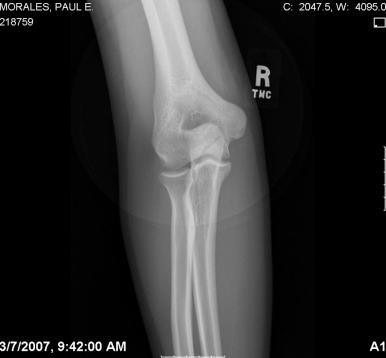
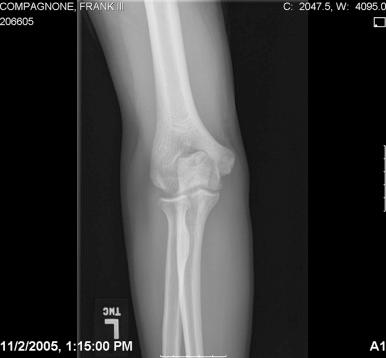
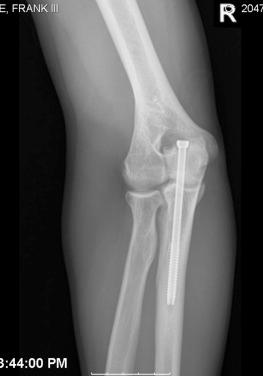
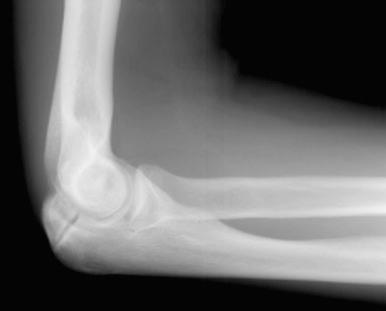
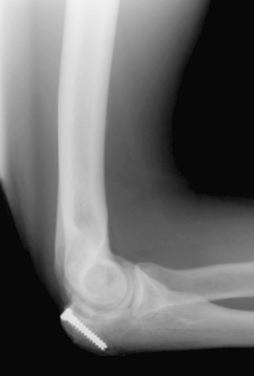
The oblique olecranon stress fracture is found most often in overhead throwing athletes and is thought to be caused by repetitive valgus extension overload ( ). A significant amount of valgus and extension force is generated across the elbow joint during the throwing motion. The ulnar collateral ligament (UCL) is the primary restraint to valgus force during throwing, with the static bony restraint of the olecranon in its fossa and the radiocapitellar joint providing secondary stability along with the dynamic restraint of the surrounding musculature (Ahmad et al, 2004b). The olecranon may traumatically impact within the posterior compartment (especially posteromedially) toward full extension because of these forces, leading to the condition of valgus extension overload syndrome (Ahmad and El attrache, 2004a). Continued valgus extension overload may in turn lead to the development of an olecranon stress fracture, which begins proximally and medially and extends toward the distal lateral olecranon cortex (see Figs. 33.1 through 33.3 ) UCL injury or deficiency is also thought to contribute to the development of olecranon stress fractures by allowing excessive valgus laxity and increased posteromedial contact ( ).
Adolescents may present with symptomatic delayed physeal closure, which is likely caused by a mechanism similar to that for the skeletally mature olecranon stress fracture, although there are certain physiologic differences between bones that are skeletally mature and immature ( ). In the study by , five types of olecranon stress fractures were described: physeal, classic (oblique), transitional (similar to transverse), sclerotic, and distal. The same study found the incidence of delayed physeal closure during a 4-year period in 1430 patients with baseball-related elbow disorders to be 2.6%, and that of all other olecranon stress fractures to be 2.8% ( ). The Furushima study did not have any outcomes data or describe which patients required open reduction with internal fixation (ORIF), but contained epidemiologic data and the classification system developed by the authors ( Figs. 33.6 through 33.9 ).
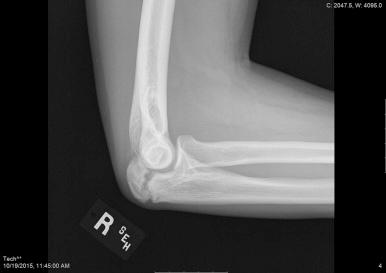
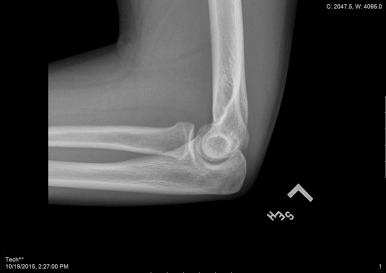
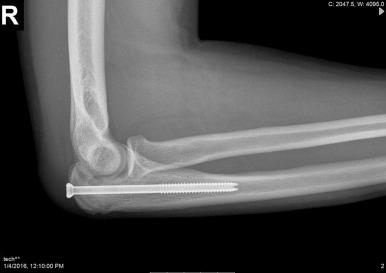
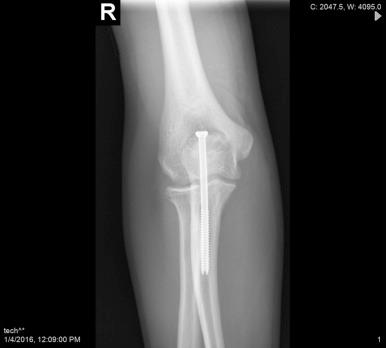
Obtaining a thorough yet focused history and physical examination is paramount. The athlete should be asked to clarify the timeline of the symptoms, whether there were any acute injuries, where the pain localizes, and what motions or activities cause the pain. Many athletes with olecranon stress fractures have progressive development of pain and soreness in the posterior elbow without a specific inciting event. However, some patients may have an acute worsening of symptoms or feel a “pop”—an event that is usually preceded by a period of pain or aching. Athletes should be asked whether they have increased their training intensity and to clarify any period of rest that they may have undergone (true rest versus slight decrease in intensity).
A thorough physical examination of the elbow and shoulder should be performed. It is very important to be vigilant for concomitant pathology. In the case series reported by , a concurrent procedure was performed on the elbow at the time of ORIF for the olecranon stress fracture in 44% of patients. (Patients typically report pain and soreness along the posterior elbow, with posterolateral pain being especially specific for an olecranon stress fracture in the authors’ experience. However, patients may complain of posteromedial pain or direct posterior pain as well, especially if they have posteromedial impingement.
In addition to examination of the posterior compartment, the UCL, flexor-pronator mass, ulnar nerve, and radiocapitellar joint should be evaluated and a thorough examination of the shoulder should be performed.
Become a Clinical Tree membership for Full access and enjoy Unlimited articles
If you are a member. Log in here